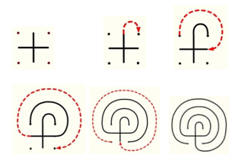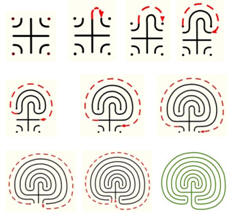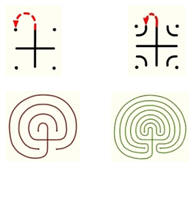December 2008 Cub Scout Roundtable Issue |
Volume
15, Issue
5
January 2008 Theme |
Theme:
A-MAZE-ing GAMES
Webelos:
Fitness and Scientist
Tiger Cub
Achievement 3 |
THEME RELATED STUFF
Alice, Golden Empire Council
Labyrinth or Maze?
Usually, a labyrinth has only one path to a center
destination, with nothing to hide the destination – people use a labyrinth to
meditate or do creative thinking. Usually, people actually walk along a
labyrinth, but they can also “walk” using their fingers on a labyrinth pattern
on paper.
A maze is designed to “hide” the destination, and usually
has high walls, false starts, dead ends – mazes made of corn have become very
popular in the last few years. There is probably a corn maze near you – check
www.dmoz.org/Games/Puzzles/Mazes/Outdoors/Corn/United_States - of course,
that would only be in the Fall! But if you go to
www.maze-world.com/menu.htm you will be amazed at all the different
materials used to make mazes – fences, stones, tiles, even mirrors. A few years
ago, an artist in California made a simple maze using fallen leaves enclosed in
“walls” of chicken wire! Some people define a maze as a way to activate your
“thinking” mind. You can also have lots of fun with mazes drawn on paper.
Instead of high walls, they have complicated pathways – you have to find just
the right one to reach the destination. You can design your own paper mazes,
but they are also available on the internet. Some mazes are even designed to be
played on the internet. Go the Web Sites section for some resources.
People have been making labyrinths for at least 5,000
years. They have been found on rock carvings, and a clay tablet with a
labyrinth on the back was found in the ruins of a store in Pylos, Greece. It
was done in 1200 B.C!
During the Middle Ages, labyrinths and mazes were often
created for meditation. A very famous one was recorded in a manuscript from the
ninth century – it described a labyrinth at Chartres Cathedral in France.
Artisans, especially in the western United States, have
begun creating new labyrinth and maze plans in the past 26 years. Sometimes,
they are temporary art installations, like one created of mounded dirt on
concrete at the Richmond Art Center about 15 years ago. But they are also
created as permanent features, sometimes in sod on mounded dirt, sometimes in
tiles. The Santa Rosa Labyrinth was created and copyrighted by Lea Goode-Harris,
Ph.D. in Sonoma, California. To see some photos of labyrinths done in sand,
snow,
www.astrolog.org/labyrnth/daedalus.htm , scroll down to Life Size Mazes, it
will take you to a huge list with photos of different mazes from all over the
world!
You can use your imagination to make either a labyrinth or
a maze – try all of these, or make up your own!
Make a labyrinth: Chalk on pavement or an open
cement area would work, but they are also made of sod, bricks on cement – of
course, you can draw one out on paper, but it is really fun to actually walk in
a labyrinth or maze! Start by drawing out two equal lines crossing in the
middle, then add dots to make four corners; then draw a half circle connecting
the top of the line with the top right-hand dot; now, draw a three-quarter
circle line connecting the right end of line with the top left dot; next,
connect the left end of line with the bottom right dot, leaving a corridor or
space between the lines as shown; the last connecting line goes from the bottom
of the center line, all the way around to the right side bottom dot, leaving a
passageway between the lines. You enter at the bottom left and walk around to
the center, without crossing any lines. This is called a Three Circuit
Classical Labyrinth, because you make three circuits to reach the middle –
people sometimes walk a labyrinth to relax, or as a means of meditation.

Here’s a more complicated version, called a Seven Circuit
Classical Labyrinth: Start with the beginning shape

Want to make a right-turning labyrinth? Just reverse these
steps on the three-circuit (on the left below) or the seven-circuit (on the
right below) By reversing these steps and all the rest of the lines, you will
have made a right-turning labyrinth.

Share Some Trivia – Did you know???
Alice, Golden Empire Council
About mazes & labyrinths……
·
The oldest hedge maze is in the gardens of Hampton Court Palace in
Surrey, England. If was built between 1689 and 1695 for King William III and
covers half an acre, with a path .5 miles long.
·
In 2001, the Pineapple Garden Maze at Dole Plantation was listed
as the world’s largest. Other record breakers were:
·
In 2003, the largest temporary corn maze opened in Christchurch,
England. It had an area of almost 17 acres, almost 9 miles of pathway, and a
lobster shape in the center. It was designed by Adrian Fisher, a world famous
maze designer.
·
A corn maze in Shippensburg, PA. from August-September of 1995,
with a path over 2 miles long . It covered 172,225 square feet.
·
In 2001, the largest permanent hedge maze was created in County
Down, Ireland, with many ordinary people helping. It covers almost 3 acres and
has a 2.18 mile long path, and is called the Peace Maze.
·
Another large permanent maze is the hedge maze in Ruurlo,
Netherlands, with an area of 94,080 square feet. It was created in 1891 from
beech hedges.
·
The largest permanent tree maze is the Samso Labyrinten on Samso
Island in Denmark has an area of 645,835 ft. with a path almost 16,000 feet
long. It opened in 2000.
·
Another permanent maze with over 16,000 yew trees lining the 1.69
miles of path, is at Longleat, England and opened in June, 1978.
·
The K.I.D.S. maze in Shaw Park, Clayton, MO was made of PVC posts,
with fencing and clear plastic stretched between the posts. It was open for May
and June of 1996 and had almost 2-1/2 miles of pathways.
·
About puzzles & games……
·
A designer or aficionado of crossword puzzles is called a
cruciverbalist.
·
A plaice, a large European flounder, can lie on a checkerboard and
reproduce on its upper surface the same pattern of squares, for camouflage.
·
“Candy Land“ was invented by Eleanor Abbott of San Diego,
California while she was recovering from polio in the 1940s. She submitted it
to Milton Bradley Company where it was immediately accepted, and is still very
popular today!
·
Playing cards were invented by the Chinese as early as 1120.
About Pinewood Derby….
P
Each year, over 2 million kits are sold in the U.S. It’s been
estimated that up to 100 million have been built since 1955!
P
Red seems to be the favorite color for Pinewood Derby cars,
followed by blue.
P
The Pinewood Derby was first run in Southern California about
1955.
P
Guess which rank usually wins most often? The Webelos
(experience counts) and then the Tiger Cubs (probably due to the help from their
adult partners).
P
The winning time between first place and the runner up is
sometimes less than 1/1000th of a second.
P
Some organizations only judge the cars and don’t even run a
Pinewood Derby race!
P
Even though there are specifications for the size, weight and
construction of the Pinewood Derby car, there are no specifications for the
raceway!
About cars & racers……
P
Actor Steve McQueen got a patent in 1971. He was famous not only
for his movies but also for racing cars and working on engines off-camera as
well. He invented the bucket seat!
P
As an advertising gimmick, Carl Mayer, nephew of lunchmeat mogul
Oscar Mayer, invented the company's "Wienermobile." The first Oscar Mayer®
“Weinermobile” drove out on July 18, 1936, and they are still around today!
P
Belgian driver Jenatzy was the first to reach a speed of over 100
km/h in his electrically powered car La Jamais Contente in 1899!
P
Ferdinand Porsche, who later went on to build sports cars bearing
his own name, designed the original 1936 Volkswagen.
P
By 1935, a full bushel of soybeans went into the manufacture of
each Ford automobile – the oil was used for enamel, paint, varnishes, and rubber
substitutes!
P
Henry Ford called his first car a quadricycle.
P
The first drive-in service station in the United States was opened
by Gulf Oil Company – on December 1, 1913, in Pittsburgh, Pennsylvania.
Materials found in Baloo's Bugle may be used by Scouters for Scouting activities provided that Baloo's Bugle and the original contributors are cited as the source of the material. |
|





